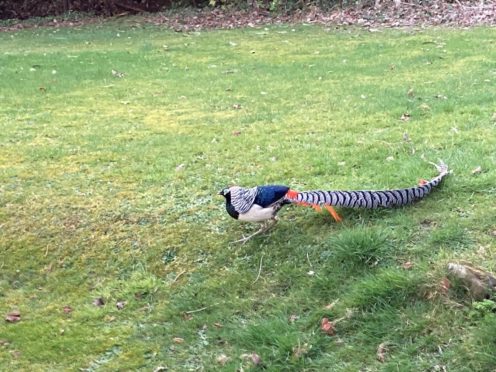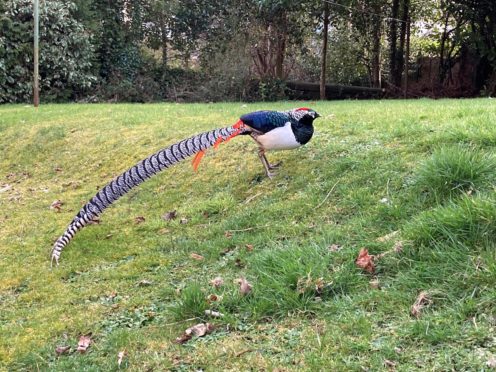An exotic game bird, believed to no longer exist in the wild in the UK, has been spotted in Fife.
The brightly coloured Lady Amherst’s Pheasant, with its striking plumage and long black and white tail feathers, was captured on camera wandering around a garden in St Andrews.
It’s thought the large bird could have possibly escaped from captivity and is now currently ‘on the run’ in the town.

St Andrews University student, Sophie Pearson, who filmed the unexpected visitor on her mobile phone, said she was stunned when she first set eyes on the bird from her flat window close to Bridge Street on Friday March 5.
“I couldn’t quite believe what I was seeing at first, especially given the size of the bird and initially thought it was a peacock,” Sophie explained.
“We rushed out to get a closer look and to our surprise it didn’t scurry off and seemed to be quite tame.
“It even came close up to eat the oats that we’d put out for it.
“It ended up staying in the garden for about 20 minutes and looked to be in good health.
“I was quite awe struck as it was an amazing looking creature and the colours were so vivid.
“Eventually it went into a tree and then disappeared not to be seen again despite leaving out some more food.”
Following the unexpected visit, Sophie contacted the British Trust of Ornithology to inform them of the sighting after going online and learning the mystery bird was a rare type.
Introduced to the Bedfordshire area by the Victorians in the 1890s, Lady Amherst’s pheasants are native to south-western China and neighbouring regions of Burma.
It’s believed there were around 50 of the birds in the county in the late 1980s, according to a paper on the species by a member of the Bedfordshire Bird Club.
By 1990, numbers had fallen to around 20 and continued to decline.
What is thought to have been the UK’s last ever Lady Amherst’s pheasant lived in woodland in Millbrook, near Bedford, and was photographed in 2015.
Paul Stancliffe, media manager for the British Trust of Ornithology, said it’s widely thought that there were no longer any self-sustaining breeding Lady Amherst’s in the wild in the UK.
But he admitted the sighting, the second to be recorded following a similar sighting in St Andrews in September 2019, was “very intriguing”.
He said: “The bird is thought to now be extinct in the wild in the UK, however, while unlikely, it’s not inconceivable that there could be a ‘rogue’ bird surviving in Fife, especially given the previous reported sighting.
“Despite its bright markings, pheasants can be extremely elusive and hard to find when they want to be so, who knows?
“I’d certainly urge anyone else who may see the bird to report it to the Fife Bird Recorder.”
Anyone who may have seen the bird is asked to email details of the sighting to grahamspa@aol.com
